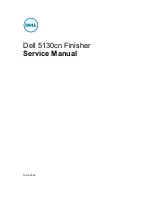
COPYRIGHT © 1998 CANON INC. FINISHER-C1/SADDLE FINISHER-C2 REV. 0 DEC. 1998 PRINTED IN JAPAN (IMPRIME AU JAPON)
2-55
CHAPTER 2 FINISHER UNIT BASIC OPERATION
III. POWER SUPPLY SYSTEM
1.
Outline
The finisher controller PCB is supplied with 24 VDC power (two channels) when the copier is
turned on: of the two channels, one is used to drive the motor solenoids, while the other is used for
sensors and ICs on PCBs after being turned into 5 VDC by the work of the regulator IC (Q9) on the
finisher controller PCB. Both channels are also used to feed power from the finisher controller PCB
to the saddle stitcher controller PCB.
Some of the 24 VDC power used to drive motors are cut off when the door switch (MS1) is
open. The power to the saddle stitcher controller PCB, however, will not be cut off.
Figure 2-301 is a block diagram showing the power supply system. The finisher controller PCB
is equipped with a battery (BAT101) for retention of memory.
5V
5V
24V
24VR
24V
24V
24V
(Q9)
BAT101
24V
Copier
Door switch
(MS1)
Saddle stitcher
controller PCB
(Saddle Finisher-C2)
Circuit breaker
(CB1)
Finisher controller PCB
Regulator IC
Motor
Motor
Solenoid
LED (Option)
Sensors
Logic
Figure 2-301
2.
Protection Functions
The 24 VDC power channel used to drive motors and solenoids are equipped with a circuit
breaker (CB1) for protection against overcurrent. The 24 V channel used to drive the feed motor
(M1), alignment motor (M3), and stapler shift motor (M4) are equipped with a fuse, which is
designed to melt in the presence of overcurrent.
Note:
Replace the lithium battery only with the one listed in the Parts Catalog. Use of different battery may
present a risk of fire or explosion. The battery may present a fire or chemical burn hazard if mistreated.
Do not recharge, disassemble, or dispose of it in fire.
Keep the battery out of reach of children and discard any used battery promptly.































